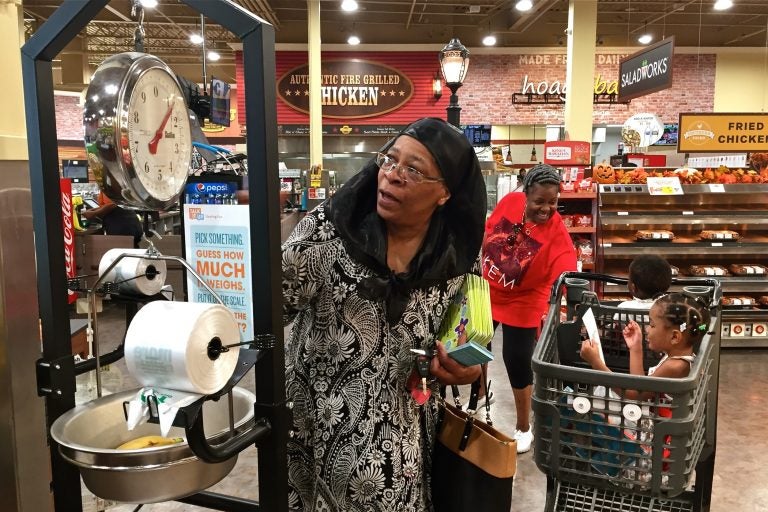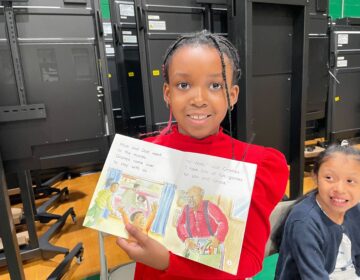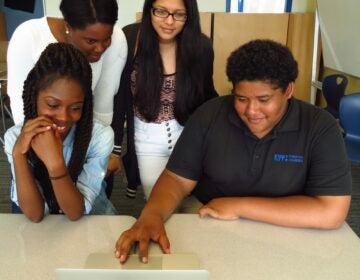Turning chores into classrooms: New grocery store experiment hopes to inspire learning
If you’re grocery shopping in Philadelphia over the next year you might run into a cherubic cartoon character named A.J.

April Ellis weighs some bananas at the Island Avenue Shoprite in Southwest Philadelphia while shopping with her grandchildren, Kalanni and Shareef. (Avi Wolfman-Arent/WHYY)
If you’re grocery shopping in Philadelphia over the next year you might run into a cherubic cartoon character named A.J.
Though his wide smile and trendy haircut impart a sense of whimsy, A.J. has a serious task. He wants to transform your daily supermarket trip into a learning laboratory.
A.J. is the face of “Talk It Up,” a pilot project aimed at inspiring interaction among parents and kids. At strategically placed sites across 10 grocery stores in Philadelphia, A.J. appears on small, laminated signs and prompts shoppers to play a quick game.
One example: In the produce section of a Southwest Philadelphia ShopRite, A.J. asks kids to pick a nearby product, guess its weight, and then use the scale below the sign to check the accuracy of their estimate.
The task involves numbers and mathematical concepts such as estimation. And the sign itself is carefully constructed to include so-called sight words, the kind that kids often have to memorize as they grope through the early stages of reading.
Above all, the prompts are supposed to inspire conversation. The hope is that parents will see household tasks as opportunities for learning instead of chores to endure.
Based on research that suggests parent-child interactions boost early learning, “Talk It Up” hopes to inspire a paradigm shift in how adults think about educating their young ones.
“What I think we really want people to realize is that it doesn’t have to look like formal education right away to be meaningful,” said Jenny Bogoni, executive director of the Read By 4th Campaign, a early literacy coalition in Philadelphia.
Discount shopping
Ideas like this have been tried in small batches, but the powers behind “Talk It Up” want to test this concept on a larger scale. By 2019, the signs will hang in 30 Philadelphia grocery stores. And if research proves the method effective, it could grow quickly after that since the initiative doesn’t require much money.
The William Penn Foundation is spending $190,000 over two years to seed the project — much of that going toward design and evaluation. If experts feel they have a replicable, effective formula, expanding to new locations won’t require much more than the blessing of retailers.
Plenty of researchers say the early years of a child’s life are critical in their brain development and eventual academic success. Since those years typically precede formal schooling, parents play a crucial role. Interventions such as home visits, though intriguing, require significant time and money.
“Talk It Up” is what experts call a “light-touch” approach, meaning it could scale quickly and with relatively little investment. The question for evaluators is whether the touch is heavy enough to make a meaningful difference.
Researchers will field test almost everything about the signs — placement, wording, adhesive techniques — to find the most effective combination. Temple University students posing as shoppers will jot down whether the prompts catch shoppers’ attention and then how they interact with the signs. Some customers will also receive surveys to gauge their impression of the campaign.
“Talk It Up” is part of a larger effort to embed learning in the physical spaces kids inhabit every day. Although there’s considerable attention paid to the time young people spend in school, much of childhood happens outside the classroom. Penetrating that world can be difficult for policy makers, and though a sign is a small step, researchers hope it’s a measurably meaningful one.
Disclaimer: The William Penn Foundation also supports Keystone Crossroads’ education coverage.
WHYY is your source for fact-based, in-depth journalism and information. As a nonprofit organization, we rely on financial support from readers like you. Please give today.






